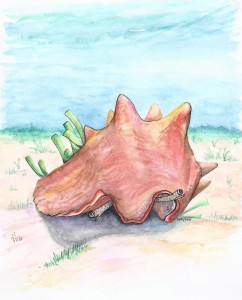The queen conch is a large mollusc harvested for food and found throughout the Caribbean Sea and Gulf of Mexico
Caribbean news. Panama city, 20 November 2014 – Some 50 experts and national authorities of the Convention on International Trade in Endangered Species of Wild Fauna and Flora (CITES) representing 23 governments and international and national organizations met in Panama City, from 18 to 20 November 2014, under the umbrella of the CFMC/OSPESCA/WECAFC/CRFMWorking Group on Queen Conch. The participants developed a new set of regional harmonized measures for the management and conservation of this large mollusc that is declining in certain areas as a result of overfishing.
The second meeting of the Working Groupreviewed a draft Queen Conch management and conservation plan with 26 potential measures and determined which measures will contribute most to the sustainability of the stocks and livelihoods of those involved in queen conch fisheries.
The experts recommended that some 16 measures are suitable for regional level harmonization and should be discussed in 2015 with all relevant stakeholders at national level in the queen conch range states. Most measures identified are applied already by a majority of range states at national level. Adoption of a final set of regionally harmonized management measures is foreseen to take place at the 16th session of the Western Central Atlantic Fishery Commission (WECAFC) and the 17th Conference of Parties to CITES in 2016.
Following-up on CITES’ 16th COP Decisions (2013) and WECAFC Recommendation WECAFC/15/2014/3 on Queen Conch, the Working Group reached also expert agreement on the use of regional harmonized conversion factors for the various degrees of processing of conch meat and a format for Non-Detriment Findings (NDFs) assessments. The NDF is a requirement from CITES to demonstrate that exported queen conch originates for a well-managed resource and that export is thus not detrimental for the stocks.
In the coming years, the Working Group aims to further advice on the experts’ agreed management and conservation measures, the development of an auditable “chain of custody” procedure to track catches from their catch location to their eventual destination and on increasing awareness and building capacity among fishers on Safety-at-Sea and particular address risk management in compressed air diving for Queen Conch.
The joint Working Group was established by the 14th session of WECAFC in February 2012 and this 2nd meeting was co-organized and sponsored by the CFMC of the U.S. Department of Commerce, the CITES Secretariat, WECAFC and FAO.
Background on queen conch
Distributed throughout the Caribbean, from the State of Florida in the United States to the northern coast of South America, queen conch is found in the territorial waters of at least 36 countries and dependent territories. They primarily inhabit sandy seafloors in clean, shallow waters, but also occur at depths of up to 100 metres. In November 1992 the species was included in Appendix II of CITES, which requires that CITES permits be issued for all exports.
 Although queen conch has been harvested for food for centuries, a large commercial fishery has developed only in the last few decades, mainly in response to growing international demand for the meat. Today, the species is one of the most important fishery resources in the Caribbean, with an annual wholesale value estimated at US$60 million. The shells are also used and traded as curios and tourist souvenirs, although they are largely considered a by-product of the meat trade.
Although queen conch has been harvested for food for centuries, a large commercial fishery has developed only in the last few decades, mainly in response to growing international demand for the meat. Today, the species is one of the most important fishery resources in the Caribbean, with an annual wholesale value estimated at US$60 million. The shells are also used and traded as curios and tourist souvenirs, although they are largely considered a by-product of the meat trade.
Over the past few decades, intensive fishing pressure has led to population declines, stock collapses and consequently the total or temporary closure of the fishery in a number of countries, states or dependent territories, including in Bermuda (UK), Cuba, Colombia, Florida (US), Mexico, the Netherlands Antilles, the Virgin Islands (US) and Venezuela.
Queen conch is one of the seven species of the family Strombidae that occur in the Western Atlantic Ocean. Queen conch is known by various names throughout its range, including: Botuto or Guarura (Venezuela); Cambombia (Panama); Cambute (Costa Rica); Caracol abulon (Guatemala); Caracol gigante (Honduras); Caracol pala (Colombia); Caracol rosado (Mexico); Carrucho (Puerto Rico); Cobo (Cuba); and Lambi (Hispaniola and French Antilles).
Note to Editors:For more information, contact Juan Carlos Vasquez at +4179-552 27 32 (mobile), or [email protected]
More information on the meeting and its outcomes can be obtained from Mr. Miguel Rolon (CFMC) at [email protected] or Mr. Raymon van Anrooy (WECAFC) at [email protected]
About CITES
With 180 Member States, CITES remains one of the world’s most powerful tools for biodiversity conservation through the regulation of trade in wild fauna and flora.
CITES regulates international trade in over 35,000 species of plants and animals, including their parts and products, ensuring their survival in the wild, with benefits for the livelihoods of local people and the global environment. The CITES permit system seeks to ensure that international trade in listed species is sustainable, legal and traceable.
CITES was signed in Washington D.C. on 3 March 1973. The United Nations General Assembly has proclaimed 3 March as World Wildlife Day.
Learn more about CITES by visiting www.cites.org or connecting to:
www.facebook.com/CITES
www.twitter.com/citesconvention
www.youtube.com/citesvd
www.flickr.com/cites




